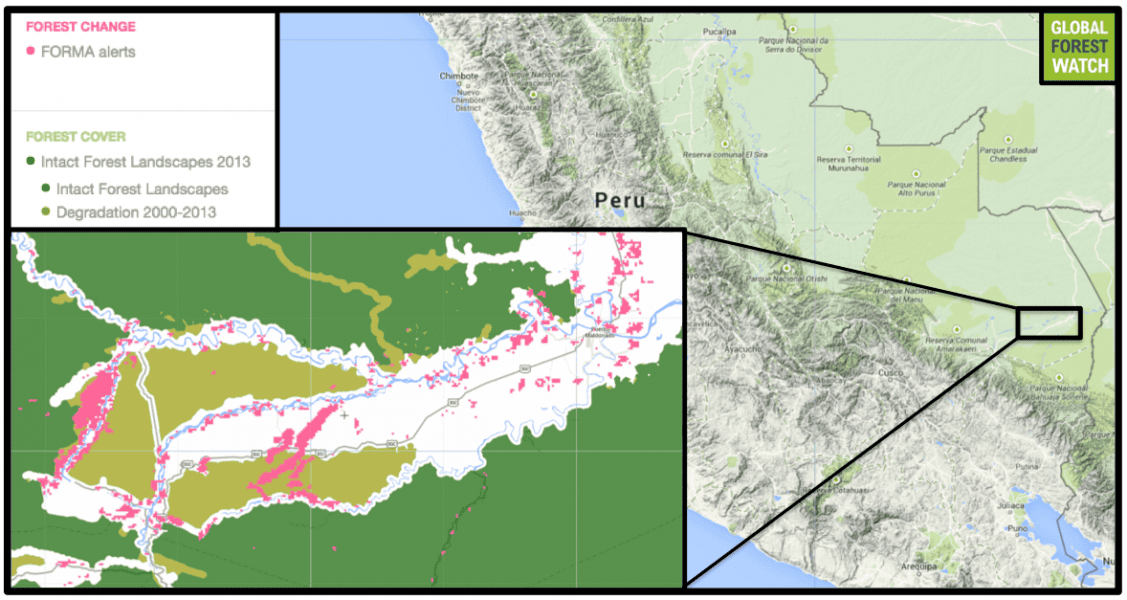- Since November 23, the Madre de Dios region in southeastern Peru has been paralyzed with protests, road blockades, and tire burnings.
- The government’s executive branch proposed the creation of a negotiation panel for sustainable development in the regio in an effort to solve the conflict with the illegal miners.
- An estimated 30,000 illegal gold miners are believed to be working in Madre de Dios alone.
Since November 23, the southeastern region of Madre de Dios in Peru has been paralyzed by street protests, road blockades, and tire burnings. Hundreds of illegal gold miners concentrated in the department’s capital, Puerto Maldonado, demanded that the government take back its plan to control illegal mining and logging. Specifically, they protested the introduction of Supreme Decree 013-2015 — which would supervise and control the sale of chemical compounds which could be used for illegal mining purposes — as well as Supreme Decree 1220, a measure that seeks to fight against illegal logging.
Environmental problems in the region, such as soil degradation and mercury contamination are largely due to gold mining and illegal logging, especially beyond protected areas and in their buffer zones. There are believed to be more than 30,000 illegal — also known as “artisanal” — gold miners operating in Madre de Dios. In March of this year, the Monitoring of the Andean Amazon Project (MAAP) revealed that 1,700 hectares were deforested due to mining in the area of La Pampa.
Leading the indefinite regional strike is the governor of Madre de Dios, Luis Otsuka. Otsuka is a former head of the illegal miners’ union, and even led protests against the Peruvian government in 2012 over the illegal activity.
The protesters argue that what’s taking them to the streets is not a defense of illegal mining, but their hesitations about Supreme Decree 013-2015, which establishes quotas for gasoline use in order to avoid it being used for illegal mining and logging operations. They argue that the quotas are affecting everybody in the region.
After many consecutive days of street protests, the executive branch of Peru’s government proposed the creation of a negotiating table for sustainable development in Madre de Dios, as an effort to resolve the conflict. The group, led by the head of the National Office for Dialogue and Sustainability, José Ávila Herrera, alongside representatives from the executive branch, seeks to promote economic development, as well as improvements in the health and education sectors.
Otsuka joined the negotiations, and during an interview with RPP Noticias, said that he shared their vision for sustainable development in the amazonian region.
“It’s important,” he said. “Us Peruvians must see more development and, as a result, peace, so that we can live with dignity. We must use our natural wealth responsibly; that’s what we all want.”
But many residents of Puerto Maldonado complained that the miners’ strike didn’t seem to show any reconciliation efforts.
“We can’t leave our homes,” said Jaime Molina to RPP Noticias. “We’re practically being held hostage by instigators who are going around the city, setting up blockades so that no one gets around by car.”
Following more than a week of protests, the situation in Madre de Dios seems to be getting worse: there are food shortages, y local businesses are suffering for lack of earnings. The government has said that the dialogue between the executive branch and the regional leaders will only continue if the strike is called off.
“We’re confident that they will call an end to the conflict as soon as possible and we’ll return to a dialogue in Madre de Dios, so that we can travel to the region and keep our conversation going,” said the head of the National Office for Dialogue and Sustainability, José Ávila Herrera.
